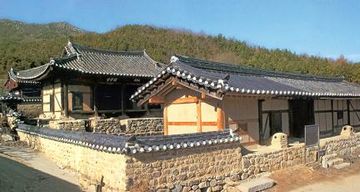"체화당"의 두 판 사이의 차이
Mkichukova (토론 | 기여) (→영문) |
Mkichukova (토론 | 기여) (→영문) |
||
| 34번째 줄: | 34번째 줄: | ||
Sangju-born Yi Jeon gathered a civilian army together with his younger brother Yi Jun (1560-1635) and fought during the Japanese invasions of 1592-1598. After the war, he briefly left his public office in 1624 and returned to his hometown where he dedicated himself to teaching students in his later years. Chehwa, meaning hawthorn flowers, is used to symbolize love and harmony between brothers, and stands for the brotherly love between the brothers Yi Jeon and Yi Jun. | Sangju-born Yi Jeon gathered a civilian army together with his younger brother Yi Jun (1560-1635) and fought during the Japanese invasions of 1592-1598. After the war, he briefly left his public office in 1624 and returned to his hometown where he dedicated himself to teaching students in his later years. Chehwa, meaning hawthorn flowers, is used to symbolize love and harmony between brothers, and stands for the brotherly love between the brothers Yi Jeon and Yi Jun. | ||
| − | This place consists of a gate quarters, Chehwadang Hall, and a shrine enshrining Ye Jeon's spirit tablet. | + | This place consists of a gate quarters, Chehwadang Hall, and a shrine enshrining Ye Jeon's spirit tablet. It consists of a wooden-floored hall in the center with an underfloor-heated room to either side, as well as a narrow wooden veranda along the front. Behind Chehwadang Hall, there is a shrine between it and the surrounding wall, separating them. The shrine that was originally built at another place in 1656, was moved to its current location in 1771. |
A shrine honoring Ye Jun (Gyeongsangbuk-do Cultural Heritage Material No. 178-2) is located about 350 m to the north of here. | A shrine honoring Ye Jun (Gyeongsangbuk-do Cultural Heritage Material No. 178-2) is located about 350 m to the north of here. | ||
2020년 11월 3일 (화) 12:02 판
| 체화당 Chehwadang Hall |
|
 체화당(178-1), 국가문화유산포털, 문화재청. |
|
| 대표명칭 | 체화당 |
|---|---|
| 영문명칭 | Chehwadang Hall |
| 한자 | 棣華堂 |
| 주소 | 경상북도 상주시 가천2길 52 (청리면, 체화당) |
| 지정번호 | 경상북도 문화재자료 제178호 |
| 지정일 | 1986년 12월 11일 |
| 분류 | 유적건조물/교육문화/교육기관/서당 |
| 수량/면적 | 3동 |
| 웹사이트 | 체화당(178-1), 국가문화유산포털, 문화재청. |
|
|
|
해설문
국문
체화당은 임진왜란 때 활약한 월간 이전(1558∼1648)이 후학을 가르치기 위해 지은 건물이다. 인조 10년(1632)에 이전의 셋째 아들 신규가 세웠다. 집 이름인 체화는 형제의 우애를 뜻하는 말로 이전과 동생인 창석 이준의 우애를 상징하는 말이다. 서산의 동쪽 산자락 끝에 관리사, 체화당, 월간사당이 동쪽을 향하게 지어졌고, 외곽에 흙돌담을 쌓았다. 사당은 다른 곳에 세워진 것을 영조 47년에 지금의 위치로 옮긴 것이며, 흙돌담으로 경계를 짓고 따로 출입문을 두었다.
체화당은 ‘ㅅ’자 모양 지붕에 기와를 이었다. 앞면 4칸, 옆면 2칸으로 넓은 대청을 중심으로 좌우에 온돌방을 대칭으로 배열하고, 방과 대청 앞으로 툇마루를 놓았다. 창과 문은 각각의 기능에 맞춰 고급 기술로 만들었다. 제사를 지내는 사당은 앞면이 3칸, 옆면이 1.5칸이고, 체화당과 비슷한 형식으로 지어졌다. 지붕 뼈대는 체화당과 같지만 화려한 무늬인 단청이 있다. 대문과 부속실이 있는 대문채는 앞면이 6칸, 옆면이 1칸이다. 대문 오른쪽으로 마루, 방, 부엌이 있고 왼쪽으로 방 2칸이 일렬로 구성되어 있다.
영문
Chehwadang Hall
Chehwadang Hall is where Yi Jeon (1558-1648, pen name Wolgan) taught his students. It was built in 1632 by Yi Jeon's third son, Yi Sin-gyu.
Sangju-born Yi Jeon gathered a civilian army together with his younger brother Yi Jun (1560-1635) and fought during the Japanese invasions of 1592-1598. After the war, he briefly left his public office in 1624 and returned to his hometown where he dedicated himself to teaching students in his later years. Chehwa, meaning hawthorn flowers, is used to symbolize love and harmony between brothers, and stands for the brotherly love between the brothers Yi Jeon and Yi Jun.
This place consists of a gate quarters, Chehwadang Hall, and a shrine enshrining Ye Jeon's spirit tablet. It consists of a wooden-floored hall in the center with an underfloor-heated room to either side, as well as a narrow wooden veranda along the front. Behind Chehwadang Hall, there is a shrine between it and the surrounding wall, separating them. The shrine that was originally built at another place in 1656, was moved to its current location in 1771.
A shrine honoring Ye Jun (Gyeongsangbuk-do Cultural Heritage Material No. 178-2) is located about 350 m to the north of here.
영문 해설 내용
체화당은 이전(1558-1648, 호 월간)이 후학을 가르치던 곳이다. 이전의 셋째 아들 이신규가 1632년에 지었다.
이전은 상주 출신으로 임진왜란 때 동생 이준(1560-1635)과 함께 의병을 모아 싸웠다. 전쟁 후 잠시 관직에 나갔다가 1624년 고향으로 돌아와 여생을 후학 양성에 힘썼다. 체화는 아가위나무 꽃을 말하며 형제간의 우애와 화목을 상징하는 말로, 이전과 이준 형제 간의 우애를 나타낸다.
이곳은 대문채, 체화당, 이전의 위패를 모신 사당으로 이루어져 있다. 체화당은 넓은 대청을 중심으로 좌우에 온돌방을 두었으며, 전면에는 툇마루를 두었다. 체화당 뒤편에는 담을 둘러 경계를 나누고 사당을 두었다. 사당은 원래 1656년 다른 곳에 세워졌던 것을 1771년에 지금의 위치로 옮긴 것이다.
이곳에서 북쪽으로 약 350m 떨어진 곳에는 이준을 모신 사당(경상북도 문화재자료 제178-2호)이 있다.
참고자료
- 상주문화원 http://www.sjcc.or.kr/bbs/board.php?bo_table=2_e&wr_id=116&page=5 -> 기본 정보
- A Bird of Paradise, 다음 블로그 http://blog.daum.net/elegant0302/2675 -> 경내 상세 사진, 인물 행적
- 조선 형제의 우애에 감동해 중국인이 그린 그림, 오마이뉴스, 2016.9.5 http://www.ohmynews.com/NWS_Web/View/at_pg.aspx?CNTN_CD=A0002241271 -> 그림 관련, 월간사당과 창석사당 구분해서 정확하게 설명한 편.